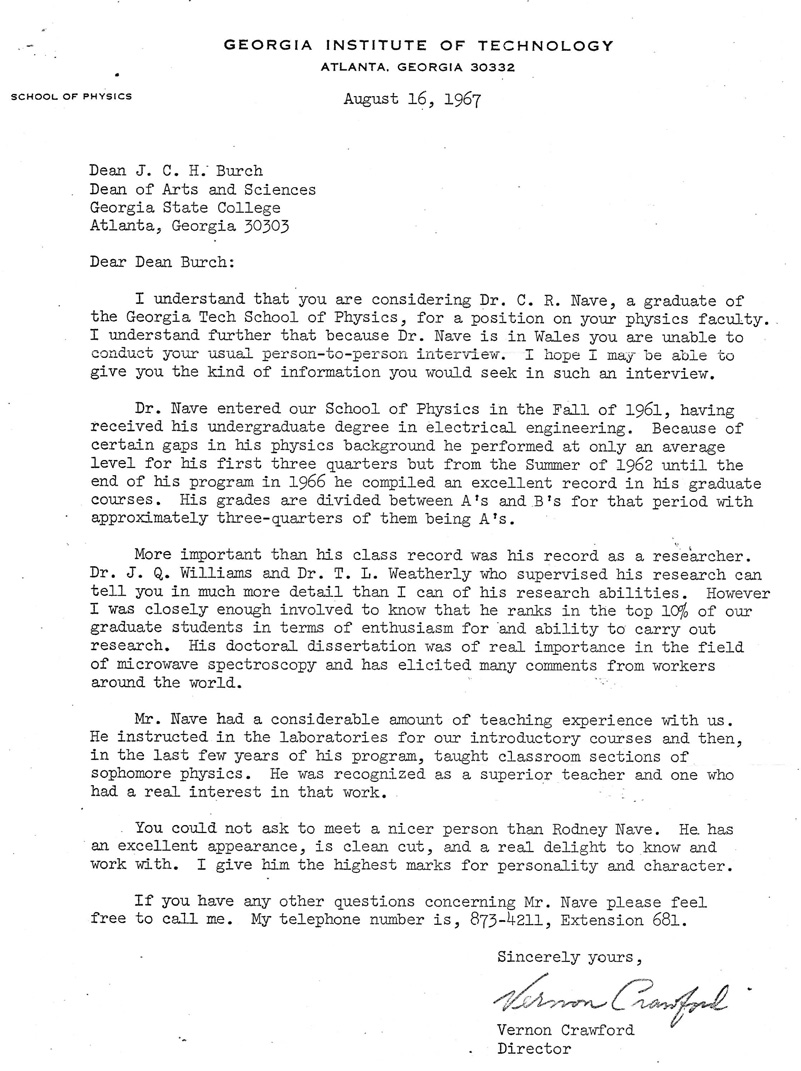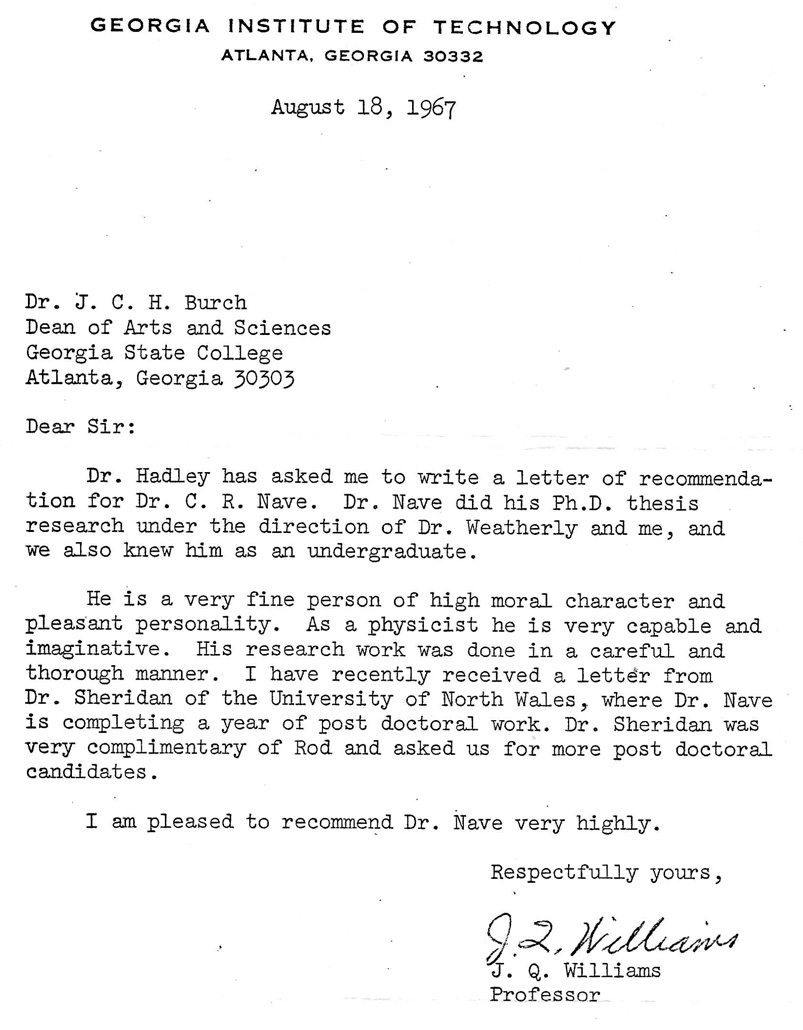Recruitment to Georgia State College
During the summer of 1967 Rod received an invitation from Dr. Joe Hadley of Georgia State College in Atlanta, inviting his application for an Assistant Professor position in the Department of Physics. Rod had no anticipation of this, but Dr. Horton Burch was Dean of Arts and Sciences at the College, so he presumed that this was the source of the initiative. We had known Horton Burch at Atlanta First Baptist Church and had actually been to his home for a student social. He had presumed that they had gotten recommendations from Dr. Quitman Williams and Dr. Tom Weatherly, who had been his dissertation advisors at Georgia Tech, but that was all the information he had at the time of the formal offer by Georgia State.
It was actually many years later, when Dr. Joe Hadley was nearing retirement, that he handed over his file of information concerning my hiring. Two letters from that file are reproduced below with part of the story associated with them.
Dr. Vernon Crawford's Recommendation
Until I received the copy of the letter many years later, I had no idea that Dr. Crawford had written a letter of recommendation for me. I had not asked him, and I presume that Dr. Hadley had asked him since he had become the Chairman of the School of Physics at Georgia Tech.
But my interaction with Vernon Crawford was quite a significant story in my education at Georgia Tech. During my sophomore year in the winter of 1959, I was invited to join a small group of about 15 students who had high academic achievements in a special honors section of the introductory electricity and magnetism physics course. Dr Crawford was to be the professor for the course, and the students included John Baxley (Math), Claude Woods (Math), Tom Cook (Physics) and Charles Frahm (Physics). These four students were considered to be the brightest students in the sophomore class. Because of the extraordinary group of students, Dr. Crawford decided against traditional A,B, C, etc for the first exam and was going to label the first exam papers with the student's rank in the class based on that exam.
On the day when the exams were handed back, everyone was anxious to find our who was number 1. Several papers were handed out before mine, and then no one was more amazed when my paper reached me and I found that it was labeled with a big #1! I was definitely not able to maintain that rank and fell well back in the queue on subsequent exams, but it definitely caused Dr. Crawford to remember me. I had had a couple of introductory electrical engineering courses before this, so that gave me a practical advantage going in.
The second course I took from Dr. Crawford was remarkable in the other direction. After receiving my Bachelor of Electrical Engineering in 1961, I had decided to enter graduate school in Physics, so I needed the introductory quantum mechanics course before starting graduate physics courses in the fall. I was doing well up until the midterm exam, but on that midterm I did the front of the exam and did not notice that there were more questions on the back of the exam! Disaster! He was generous to give me a D on the midterm and a C in the course.
In graduate school I took an optics course from Dr. Crawford and did very well, making a high A in that course. So that helped salvage my reputation.
The final story in my experience with Dr. Crawford came at the time of the PhD Comprehensive Examination at the end of my graduate physics coursework. I studied all summer and did well on the three day written examination. The final and most dreaded part of the "Comps" was the oral examination by the whole physics faculty. I had a strong experimental background and inclination, so I most feared the theoreticians on the faculty, particularly the two who taught relativistic quantum mechanics.
I stood to face that faculty with the same kind of fear that most would have, wondering what was coming at me. To my surprise, Dr. Vernon Crawford promptly stuck up his hand and asked the first question! "Rod, we have a new student on campus who doesn't believe in electrons! What would you tell him to convince him that there is such a thing!" So I started with a description of a cathode ray tube with a gas to show the path of the beam. Then by applying a magnetic field to bend the beam, I could measure the charge-to-mass ratio of the particles in the beam. I argued that the consistently measured charge-to-mass ratio e/m essentially defined an electron, and responded to their questions about that. It generated quite a discussion and chewed up a large part of the time in which I was "on trial". Although there were other types of questions, this exchange calmed me and allowed my experimental bent to be utilized. It was not until later that it dawned on me that this was a deliberate move of the part of Vernon Crawford to thrust me into an experimental area which he knew to be my strength.
Years later I received this copy of the letter of recommendation he wrote. He had then become the Chairman of the School of Physics.

By the time I was settled in on the faculty of Georgia State College, Vernon Crawford had become the Chancellor of the University System of Georgia.
Dr. Quitman Williams' Recommendation
I was quite privileged to work under Dr. J. Quitman Williams and Dr. Tom Weatherly for my Ph.D. Thesis work in microwave spectroscopy. They were certainly reasonable and helpful and it was a pleasure to work with them. I learned a great deal about molecular spectra in a course taught by Dr. Weatherly and about the experimental approach to molecular spectroscopy from both of them. I had presumed that they had recommended me to Georgia State College, but had not received any documentation to that effect until years later. This is a copy of Quitman Williams' letter.

Certainly in retrospect, I have to consider myself very blessed to have had such capable and helpful teachers and directors who actively worked to help me and advance my own career in the academic setting.
| Hobson family portrait |
1967